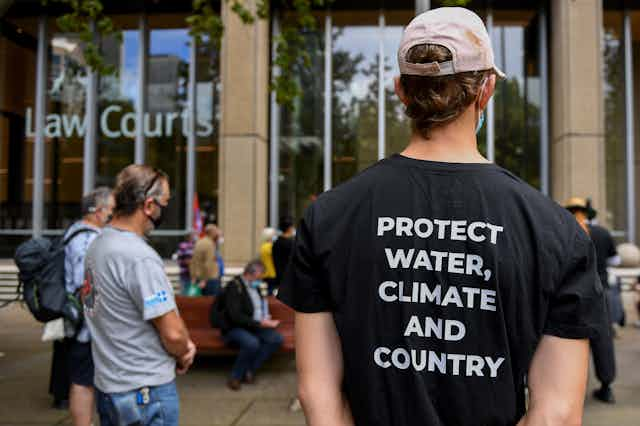In a significant win for the Gomeroi People, the Federal Court has ruled climate change impacts must be properly considered when determining whether a fossil fuel project can go ahead on native title land.
This is the latest in a series of disputes involving First Nations people fighting to prevent coal, oil and gas projects on their land. It’s part of the growing trend of First Nations people spearheading climate litigation. For example, cases involving Raelene Cooper, Dennis Tipakalippa, and Pabai Pabai.
This week’s legal decision is the first of its kind because the Court ruled climate change must be part of the public interest test before the National Native Title Tribunal can allow a project to proceed on native title land.
The decision puts native title holders in a stronger position when fighting to prevent future fossil fuel projects. There’s no guarantee of success, but it’s clear climate impacts can no longer be dismissed.
An uphill battle for Traditional Owners
The win for the Gomeroi People was about a dispute relating to native title approvals made by the National Native Title Tribunal in 2022. This gave the Australian oil and gas company Santos permission to proceed with plans to extract gas from forest and farmland around Narrabri, in northern New South Wales.
Up to 850 gas wells would be drilled over 20 years to extract coal seam gas. The wells and infrastructure, including gas processing and water treatment facilities, would be located within 1,000 hectares of the 95,000ha project area.
Under the Native Title Act companies like Santos are required to negotiate with the land’s Traditional Owners for at least six months with a view to reaching an agreement.
But an obligation to negotiate does not mean there is an obligation to reach an agreement. Traditional Owners cannot veto the project. And even without an agreement the company can apply to the tribunal to grant native title approvals.
Companies know they are likely to win once they get to the tribunal. The tribunal has only ever sided with native title holders trying to prevent resource extraction project on their Country three times, most recently back in 2011. In comparison, it has sided with the developer 149 times.
The tribunal must look at a range of factors when reaching its decision. This includes the public interest.
The Gomeroi People argued greenhouse gas emissions from the Santos project would cause unacceptable damage to their Country, and also contribute to global climate change, and therefore the project was not in the public interest.
They enlisted an expert witness, the late and highly respected climate scientist Professor Will Steffen, who told the tribunal in 2021 that the project was expected to result in between 109.75 million and 120.55 million tonnes of extra carbon dioxide (or equivalent) into the atmosphere.
The continued expansion of the fossil fuel industry, Steffen said, would result in the Narrabri region experiencing “more extreme heat, further and more intense droughts, harsher fire danger weather, and heavier rainfall when it occurs, all of which will continue to increase in frequency and intensity”.
The tribunal’s then president, John Dowsett, concluded that while he accepted greenhouse gas emissions were warming the planet, it was not in his remit to consider climate change when looking at the public interest. Rather, he said, he had to consider factors such as whether the project was of “economic significance to Australia, the State and the region, as well as Aboriginal people”.
He ruled that it was, and also opined that Steffen should have been more deferential to the NSW Independent Planning Commission’s views that the project would have an acceptable impact on climate. Steffen was just “one scientist”, Dowsett said, and it was “disturbing” that he should dismiss the authority’s view.
Dowsett even referenced the classic climate fallacy about there being two sides to the argument: “there are conflicting views concerning climate change and knowledge is rapidly expanding”.
Read more: Groundwater: the natural wonder that needs protecting from coal seam gas
A groundbreaking win
The Federal Court was clearly not impressed, this week delivering the tribunal a judicial slap. The court said the definition of what was in the public interest was wide, and in this case, consideration of climate change impacts clearly fell within that definition.
In her judgement, Federal Court Chief Justice Debra Mortimer pointed out that Steffen was not just one scientist, but rather was on a panel of experts of the United Nations’ Intergovernmental Panel on Climate Change, representing the world’s leading climate scientists.
Gomeroi Traditional Owners reacted to the decision with happiness, pride and celebration.
Gomeroi Elder Maria (Polly) Cutmore released a statement saying:
Santos now have to decide what they are going to do, we strongly encourage them to withdraw their operations from the Pilliga forest and our floodplains for good. That would respect our culture and law and Santos would be better off for it.
Santos responded to the case by saying it has “at all times negotiated with the Gomeroi people in good faith”.
This is not the first time First Nations people have led the way in holding decision makers accountable for the climate consequences of their actions. Indeed, Australia has been a particularly active jurisdiction for climate litigation, the jurisdiction with the second-highest number of cases worldwide. The Australian and Pacific Climate Litigation database we run at the University of Melbourne records these cases.
We expect more of these disputes to arise in the future.
What comes next?
For the Gomeroi People, the matter will likely be sent back to the tribunal with instructions to revisit the decision. This time, we hope, climate change will be forefront in the decision-making process.
The broader implications of this latest ruling are still unclear. It is conceivable the tribunal will reconsider the climate impacts and yet still arrive at the same conclusion.
Alternatively, this case could be the start of more significant engagement with climate issues in Australian courts, led by First Nations people.

